#education budget 2023
Explore tagged Tumblr posts
Text
Comparison of Education Budgets 2023 and 2024.
The increase in the education sector's budget from 2023-24 to 2024-25 in India represents a purposeful governmental plan targeted at strengthening the foundation and quality of education across the country. Budget allocations under Finance Minister Nirmala Sitharaman have demonstrated a commitment to strengthening educational infrastructure, increasing accessibility, and fostering an environment of innovation and excellence. This comparison article delves into the intricacies of both fiscal years' budgets, illuminating variations in priorities, allocations, and the ramifications for India's educational future.
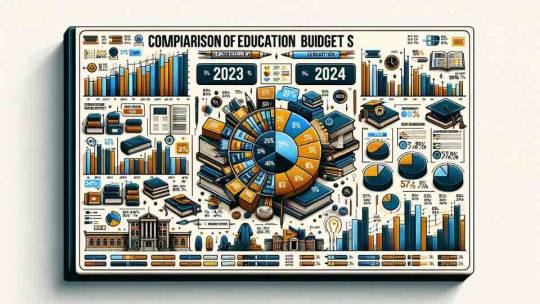
Introduction to Education Budget Allocations
Fiscal Year 2023-24 Highlights:
The Department of School Education and Literacy received a significant boost, with allocations rising to ₹68,805 crore, marking a 15.6% increase.
Higher Education saw an 8% increase, with ₹44,094 crore allocated.
Notable initiatives included the PM-SHRI plan, with ₹4,000 crore earmarked to transform over 14,500 schools, and the establishment of the National Research Foundation with a ₹2,000 crore allocation.
Fiscal Year 2024-25 Highlights:
The Department of School Education and Literacy's budget rose further to ₹73,008.10 crore.
Higher Education's budget also increased to ₹47,619.77 crore.
The PM SHRI initiative received a higher allocation of ₹6,050 crore, indicating an enhanced focus on exemplary school education.
Comparative Analysis of Budgetary Allocations
Increased Funding for Education:
Both years saw substantial increases in allocations, with the 2024-25 budget continuing the upward trend. The total education ministry budget stood at ₹1,20,627.87 crore, up from the previous year's ₹1,12,898.97 crore.
Emphasis on School Education:
The continued increase in the budget for the Department of School Education and Literacy underscores a strategic focus on strengthening school infrastructure and learning outcomes.
Higher Education and Research:
Higher Education received a boost in both years, reflecting a commitment to elevating academic standards and fostering research. However, the Education budget of 2024-25 does not specifically mention new allocations for creating IITs or leading institutions, as was the case with the MERITE initiative in 2023-24.
Innovative Initiatives and Program Funding:
The PM SHRI schools initiative received increased funding in 2024-25, highlighting a focused effort to enhance the quality of school education.
The National Research Foundation's establishment in 2023-24 with a ₹2,000 crore allocation marked a significant step towards promoting R&D, although specific allocations for NRF in 2024-25 were not detailed.
Policy Implications and Sectoral Impact
Shifting Priorities and New Directions:
The budgets for both years reflect a shift towards modernizing education through technology, research, and innovation, albeit with different focal points each year.
The emphasis on PM SHRI schools in 2024-25 suggests a move towards creating model institutions as beacons of educational excellence.
Concerns and Opportunities:
While the increase in budget allocations is promising, the education sector's funding as a percentage of GDP remains a concern, hovering around 2.9% in 2023-24, with a long-term goal of reaching 6% as per the National Education Policy.
The focus on specific initiatives like PM SHRI and PM POSHAN in 2024-25 demonstrates a holistic approach to education, addressing both academic and nutritional needs.
Conclusion: A Forward-Looking Agenda
The budgets for 2023-24 and 2024-25 represent India's ambitious goal for the education sector. By gradually increasing appropriations and carefully focusing on sectors such as school infrastructure, higher education, research, and nutrition, the government is establishing a solid basis for a future-ready education system. These budgets clearly indicate a commitment to prioritizing education as a crucial engine of national development, with the goal of ensuring that every student has access to a high-quality learning environment and is prepared to contribute to India's worldwide advancement. The task ahead is to effectively implement these measures and ensure that greater allocations result in demonstrable gains across the educational landscape.
Check: Preschool in Wagholi, Preschool in Noida
0 notes
Text
Wausau School Board gives preliminary nod to proposed tax levy
The final revenue numbers will be reevaluated before the final budget and levy on Oct. 23.
Damakant Jayshi The Wausau School Board on Monday gave its initial approval to a proposed levy of $49.69 million, an increase of $1.4 million over last year. The board also approved a preliminary 2023-2024 General Fund budget of $117,685,808 for expenses and $116,961,848 for revenue. The Annual Meeting and Budget Hearing will be on Sept. 25. The final approval of the 2023-24 budget is expected…

View On WordPress
#afternoon update#Wausau School District#Wausau School District 2023-24 budget#Wausau School District 2023-24 tax levy#Wausau School Board#WSB Education/Operations Committee#WSD mill rate
0 notes
Video
youtube
Cabinet (Liverpool City Council) 6th June 2023 Part 1 of 2
#youtube#Cabinet#Liverpool City Council#Liverpool Town Hall#Liverpool#Leader of the Council Announcements#Councillor Liam Robinson#Highways Investment Programme - New Call-off Contracts and update and proposals for financial years 2023/4 and 2024/5#Cabinet Recommendations#UK Shared Prosperity Fund Place Based Business Support#Approval to enter into grant agreement with Department for Education Grant Funding#Adult Education Budget 2023-24: Receipt of grant allocation from the Liverpool City Region Combined Authority#councillors#local government#Eurovision#OFSTED
0 notes
Link
The Indian Budget 2023 has come up with several initiatives that are expected to provide a major boost to the export sector in India. From an increased focus on MSMEs to the simplification of customs procedures and the encouragement of electronic transactions, the budget is aimed at making India a hub for international trade and providing ample opportunities for businesses looking to expand their horizon and tap into new markets. By providing a supportive environment for businesses, the Indian government is aiming to make the country a major player in the global economy and provide a fillip to the export business in India.
#Indian Budget#Budget 2023#Indian Budget 2023#export#textiles#exporter#exim#Business#business opportunity#business idea#international business#import export business#export business#india#education#knowledge#educacion#globaleducation#exportimportprocedure#apeda#development#entrepreneur#entreprenuership#documentation#supplier#supply chain#iec code#IEC#shippingworldwide#Freeshipping
1 note
·
View note
Text

Via NasAlSudan
Learn about the Sudanese revolution, the significance of December 19, and a legacy of resistance and resilience.
Join our call to action today and everyday during Sudan Action Week.
December 19 2023
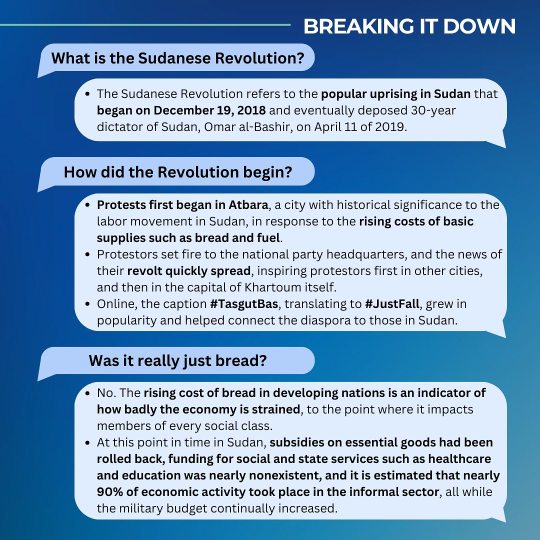
Transcript:
Breaking it down
What is the Sudanese Revolution?
The Sudanese Revolution refers to the popular uprising in Sudan that began on December 19, 2018 and eventually deposed 30-year dictator of Sudan, Omar al-Bashir, on April 11 of 2019.
How did the Revolution begin?
Protests first began in Atbara, a city with historical significance to the labor movement in Sudan, in response to the rising costs of basic supplies such as bread and fuel.
Protestors set fire to the national party headquarters, and the news of their revolt quickly spread, inspiring protestors first in other cities, and then in the capital of Khartoum itself.
Online, the caption #TasgutBas, translating to #JustFall, grew in popularity and helped connect the diaspora to those in Sudan.
Was it really just bread?
No. The rising cost of bread in developing nations is an indicator of how badly the economy is strained, to the point where it impacts members of every social class.
At this point in time in Sudan, subsidies on essential goods had been rolled back, funding for social and state services such as healthcare and education was nearly nonexistent, and it is estimated that nearly 90% of economic activity took place in the informal sector, all while the military budget continually increased.
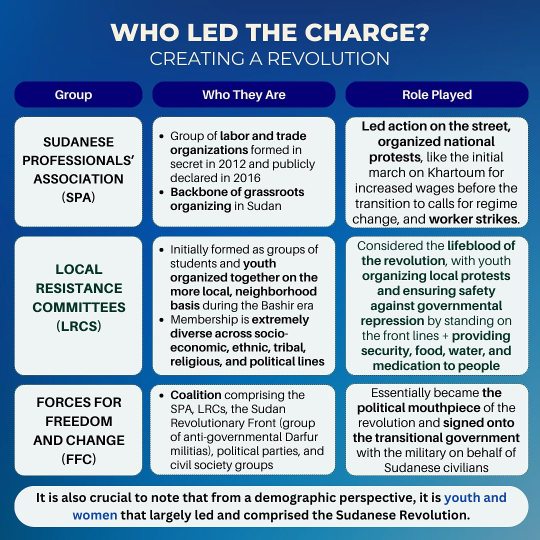
Transcript:
Who led the charge? Creating a revolution
Group: Sudanese Professional's association (SPA)
Who they are:
Group of labor and trade organizations formed in secret in 2012 and publicly declared in 2016
Backbone of grassroots organizing in Sudan
Role played:
Led action on the street, organized national protests, like the initial march on Khartoum for increased wages before the transition to calls for regime change, and worker strikes.
Group: Local Resistance Committees (LRCS)
Who they are:
Initially formed as groups of students and youth organized together on the more local, neighbourhood basis during the Bashir era
Membership is extremely diverse across socio-economic, ethnic, tribal, religious, and political lines
Role played:
Considered the lifeblood of the revolution, with youth organizing local protests and ensuring safety against governmental repression by standing on the front lines + providing security, food, water, and medication to people
Group: Forces for freedom and change (FFC)
Who they are:
Coalition comprising the SPA, LRCS, the Sudan Revolutionary Front (group of anti-governmental Darfur militias), political parties, and civil society groups
Role played:
Essentially became the political mouthpiece of the revolution and signed onto the transitional government with the military on behalf of Sudanese civilians
It is also crucial to note that from a demographic perspective, it is youth and women that largely led and comprised the Sudanese Revolution.
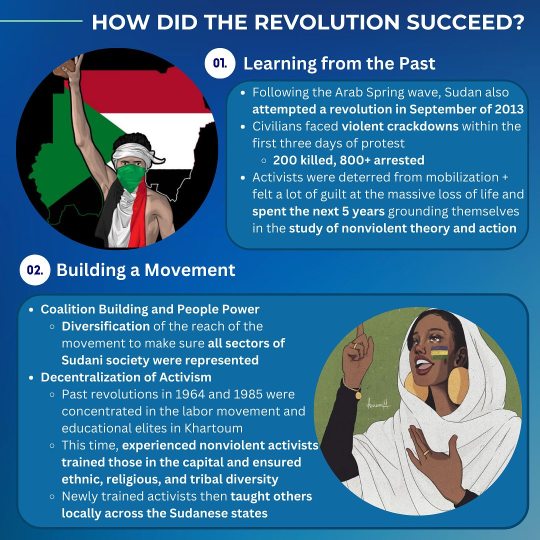
Trabscript:
How did the revolution succeed?
01. Learning from the Past
Following the Arab Spring wave, Sudan also attempted a revolution in September of 2013
Civilians faced violent crackdowns within the first three days of protest. 200 killed, 800+ arrested
Activists were deterred from mobilization + felt a lot of guilt at the massive loss of life and spent the next 5 years grounding themselves in the study of nonviolent theory and action
02. Building a Movement
Coalition Building and People Power
Diversification of the reach of the movement to make sure all sectors of Sudani society were represented
Decentralization of Activism
Past revolutions in 1964 and 1985 were concentrated in the labor movement and educational elites in Khartoum
This time, experienced nonviolent activists trained those in the capital and ensured ethnic, religious, and tribal diversity
Newly trained activists then taught others locally across the Sudanese states
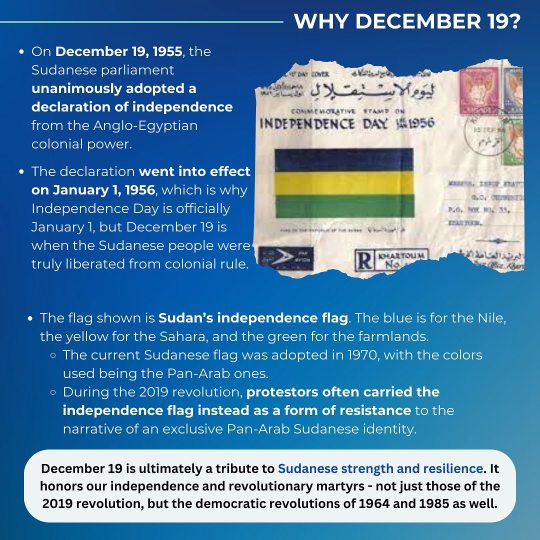
Transcript:
Why december 19?
On December 19, 1955, the Sudanese parliament unanimously adopted a declaration of independence from the Anglo-Egyptian colonial power.
The declaration went into effect on January 1, 1956, which is why Independence Day is officially January 1, but December 19 is when the Sudanese people were truly liberated from colonial rule.
The flag shown is Sudan's independence flag. The blue is for the Nile, the yellow for the Sahara, and the green for the farmlands.
The current Sudanese flag was adopted in 1970, with the colors used being the Pan-Arab ones.
During the 2019 revolution, protestors often carried the independence flag instead as a form of resistance to the narrative of an exclusive Pan-Arab Sudanese identity.
December 19 is ultimately a tribute to Sudanese strength and resilience. It honors our independence and revolutionary martyrs - not just those of the 2019 revolution, but the democratic revolutions of 1964 and 1985 as well.
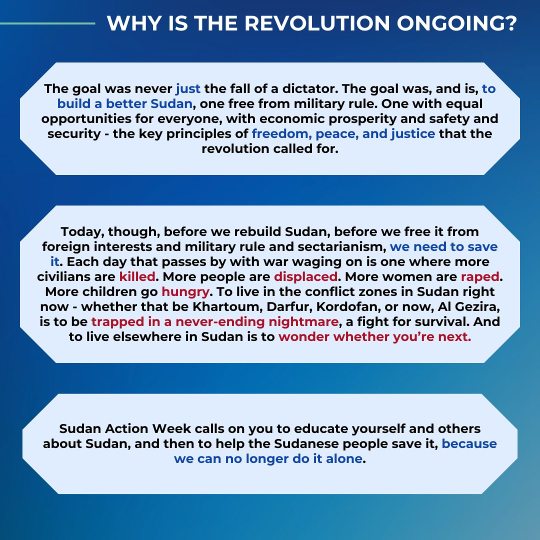
Transcript:
Why is the revolution ongoing?
The goal was never just the fall of a dictator. The goal was, and is, to build a better Sudan, one free from military rule. One with equal opportunities for everyone, with economic prosperity and safety and security - the key principles of freedom, peace, and justice that the revolution called for.
Today, though, before we rebuild Sudan, before we free it from foreign interests and military rule and sectarianism, we need to save it. Each day that passes by with war waging on is one where more civilians are killed. More people are displaced. More women are raped. More children go hungry. To live in the conflict zones in Sudan right now - whether that be Khartoum, Darfur, Kordofan, or now, Al Gezira, is to be trapped in a never-ending nightmare, a fight for survival. And to live elsewhere in Sudan is to wonder whether you're next.
Sudan Action Week calls on you to educate yourself and others about Sudan, and then to help the Sudanese people save it, because we can no longer do it alone.
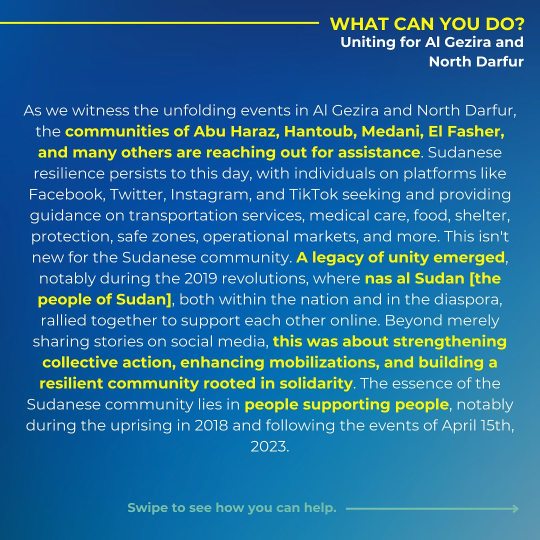
Transcript:
What can you do? Uniting for Al Gezira and North Darfur
As we witness the unfolding events in Al Gezira and North Darfur, the communities of Abu Haraz, Hantoub, Medani, El Fasher, and many others are reaching out for assistance. Sudanese resilience persists to this day, with individuals on platforms like Facebook, Twitter, Instagram, and TikTok seeking and providing guidance on transportation services, medical care, food, shelter, protection, safe zones, operational markets, and more. This isn't new for the Sudanese community. A legacy of unity emerged, notably during the 2019 revolutions, where nas al Sudan [the people of Sudan], both within the nation and in the diaspora, rallied together to support each other online. Beyond merely sharing stories on social media, this was about strengthening collective action, enhancing mobilizations, and building a resilient community rooted in solidarity. The essence of the Sudanese community lies in people supporting people, notably during the uprising in 2018 and following the events of April 15th, 2023
Swipe to see how you can help.
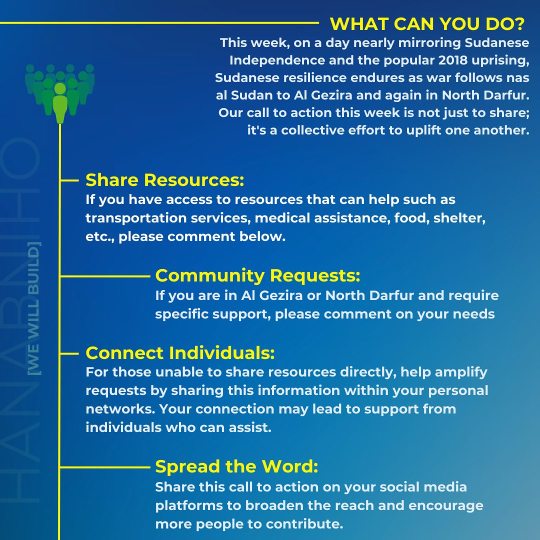
Transcript:
What can you do?
This week, on a day nearly mirroring Sudanese Independence and the popular 2018 uprising, Sudanese resilience endures as war follows nas al Sudan to Al Gezira and again in North Darfur. Our call to action this week is not just to share; it's a collective effort to uplift one another.
Share Resources:
If you have access to resources that can help such as transportation services, medical assistance, food, shelter, etc., please comment below.
Community Requests:
If you are in Al Gezira or North Darfur and require specific support, please comment on your needs
Connect Individuals:
For those unable to share resources directly, help amplify requests by sharing this information within your personal networks. Your connection may lead to support from individuals who can assist.
Spread the Word:
Share this call to action on your social media platforms to broaden the reach and encourage more people to contribute.

Transcript:
Hanabniho
حنبنيهوا
[We will rebuild]
#keepEyesOnSudan
#SudanActionWeek
924 notes
·
View notes
Text
GLOBAL STRIKE FOR GAZA 1/21-1/28
Apologies for my delay in using my platform, I found out about this strike yesterday and was taking some time to figure out what to say
Palestine has been suffering long before October 2023 and I need everybody to understand that. There is a genocide happening right now and if people don't use their voices to speak up, then they will become a lost cause in our history. We do not want the stories of their people to be told 50 years from now with a side comment like "oh no I wish someone would've done something" or "I can't believe that actually happened." Our voices can spread like a wildfire, so I hope that everybody joins the global strike this week in support of Palestine and uses their voices, social media, platforms, etc to voice their support.
If you are unsure of where to start, I suggest reading up on the history of Israel's occupation of Palestine dating back to 1948. Here is a free PDF download of this book. To be honest, I have not finished reading this book yet, but it's been highly recommended to me by multiple people. Buying the book from the author would be better, but I understand that it's not within everybody's budgets which is why I included that link.
______________________________________________________________
If you follow this link, this is a great guide on how to participate and support the strike this week. Doing every single thing is not realistic but do what you can and that is enough.
Here are some Palestinian journalists you can follow on Twitter, as they are the most reliable source. Many news sources worldwide have been misconstruing this "conflict" and completely ignoring the blatant genocide happening before our eyes. These journalists are Palestinian people who have been living this their whole lives (there are many more people and the Twitter thread can be viewed here)


Additionally, here are some other Twitter accounts that you can receive information from.
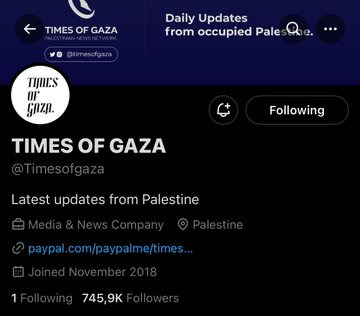
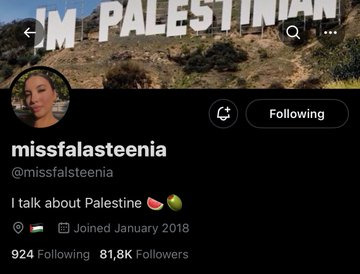
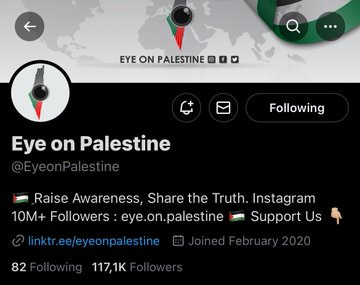
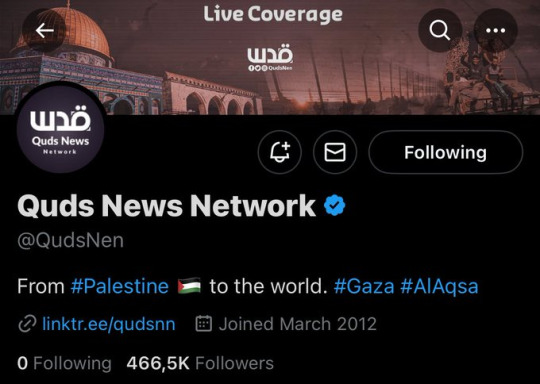
I urge everybody (art blogs, fandom blogs, etc) to put their interests on pause for the week and use that time to educate themselves on what's been going on for the last several years. This did not start in October. Keep speaking up and uplift Palestinian voices!
______________________________________________________________
Resources and other ways to help:
BOYCOTT STARBUCKS AND MCDONALDS (among other things)
Donate E-Sims to help journalists be in touch with the rest of the world
Stop supporting Zionist celebrities (ex: Noah Schnapp, Gal Gadot)
Uplift Palestinian journalists
Donate menstrual products to menstruating people in Gaza
Donations to UNRWA, Islamic Relief Canada, Arab (daily clicks and proceeds go to UNRWA)
If I missed anything, please feel free to message me or send me something in my inbox. Again, I urge everybody to pause their week to stand in solidarity with the Palestinian people and continue to uplift their voices. We are all stronger together.
#free palestine#palestine resources#tagging fandom-related things to increase exposure!!! please spread word!#I will refrain from posting DNP-related things for this week as well (with the occasional post to balance out for the algorithm so i don't-#get shadowbanned)#dan howell#phil lester#amazingphil#danisnotonfire#dan and phil#phandom#phan#dnp#dapgames#dan and phil games#dan and phil edit#fandom#meme#shitpost#from the river to the sea palestine will be free#ceasefire#free gaza#palestinian genocide#current events
292 notes
·
View notes
Text
Very cool study titled "Recommendations for Gaming and Play in Holocaust Memory and Education" just dropped on my linkedin feed, via study contributor Dr. Christine Beresniova.
Its opening paragraphs read:
Digital games are becoming increasingly significant within Holocaust memory and education as professional memory institutions continue to explore the affordances of integrating digital technologies. The so-called Holocaust gaming taboo which has burdened both the mainstream gaming industry and small indie studios seems to show signs of lifting. Scholars have pointed out that major FPS (first-person shooter) franchises such as Wolfenstein and Call of Duty have only teetered on representation of this past, often taking liberty with Nazi themes while placing the Holocaust within the margins or completely eliding the persecution of European Jewry altogether. At the other end of the spectrum, game designers working with small budget proposals had been “promptly pressured to abandon the project” due to the backlash in public discourse, often prompted by professional Holocaust organisations denouncing the very premise of Holocaust games. However, the rising prominence of indie studios such as Paintbucket Games responsible for the historical resistance sim Through the Darkest of Times (2020), as well as the recent Forced Abroad (2022) and The Darkest Files (forthcoming), and Prague-based studio Charles Games who have produced Attentat 1942 (2017); Liberation Svoboda 1945 (2021) and Train to Sachsenhausen (2022) mark the significant shift underway. Indeed, professional Holocaust memory institutions such as the Neuengamme Concentration Camp Memorial and the Arolsen Archives are working in collaboration with game designers and developers to produce digital games on the subject. Furthermore, one designer, who faced public backlash for a game project designed as early as 2013, has since released The Light in the Darkness (Voices of the Forgotten, 2023) and is responsible for creating the first Holocaust Museum in Fortnite (Epic Games, 2023). This would not be the first Holocaust museum in a gaming environment, however. The United States Holocaust Memorial Museum launched ‘Witnessing History: Kristallnacht, the 1938 Pogroms’ in Second Life (c. 2008). The proliferation of interest in the medium’s potential to offer new modes for engaging with the past raises critical questions regarding opportunities for digital Holocaust memory practice, while also bringing into sharp focus issues regarding player/user experience, contextualisation, accessibility, funding and digital obsolescence. This report serves as an important first step in this work.
You may read the full report here. I'll be reading it later today or tomorrow. Very excited engage with this new(ish) terrain of Holocaust memory construction!
55 notes
·
View notes
Text
Daily update post:
Today, the IDF is beginning its internal investigation into the failure to prevent the Hamas massacre on Oct 7. The investigation will check the way the army handled all relevant aspects, covering the period of 2018 until Oct 10, 2023. The investigation is operative in nature, it's not meant to single out and punish the guilty (there will likely be a separate investigation for that later, after the war), it'll be more focused on understanding mistakes that were made, in order to prevent them from occurring again.

It's kind of ironic, how quick westerners are to accuse Israel of genociding Arabs, meanwhile Arab countries (even ones that say similar things) are still looking to collaborate with Israel. In its peace treaty with Jordan, Israel agreed to supply its eastern Arab neighbor with an annual amount of water, but has in reality implemented a deal, where it supplies Jordan with twice the amount it's obligated to. Now, Jordan is asking Israel to extend this water deal by at least another year. Jordan has been one of the more hostile Arab countries when it comes to Israel since the start of the war in Gaza (which is no surprise, since it's the Arab country with the most substantial Palestinian population). Jordan has even gone so far as to back up South Africa in its ICJ case blaming Israel of committing genocide. If Jordan really believed that Israel seeks to genocide Arabs, would this Arab kingdom really be asking the Jewish state to supply it with water? Would it allow itself to depend on Israel for its water supply? Would it be able to say, "please extend this water deal," showing it has in the past trusted Israel with its water supply, and has gotten exactly what it was asking for? Israel is asking Jordan in return to tone down its anti-Israel rhetoric.

There are reports coming out of Russia, that today, an ISIS cell was stopped before committing a terrorist attack against a local synagogue in Moscow.

In the Netherlands, anti-Israel activists have demanded the arrest of the Israeli president when he arrives in the country for a state visit. I have to point out two things. First, the president's role in Israel is mainly a ceremonial one, he has almost no executive power (the most meaningful action he can take, is in pardoning, or refusing to pardon, prisoners). Second, there are Hamas seniors living in and traveling to Europe freely. People who are leading the genocidal, antisemitic Islamist terrorist organization which committed the Oct 7 atrocities are free to come and go as they please, while Israeli officials, even ceremonial ones, have to be worried about their freedoms. This is a twisted reality we are living in.
This:

vs this:

Remember how many countries froze their UNRWA funding, after info started coming out that its employees had participated in the Hamas massacre, and how many of them have ties to Hamas and other Palestinian terrorist organizations? Turns out that this only froze about half of UNRWA's annual budget, that quietly some of these countries have begun trickling money back to UNRWA, and that Canada is about to unfreeze its funding for this UN agency. Ask Canadian Prime Minister Trudeau where is the body of Yonatan Samerano, kidnapped by an UNRWA member. Ask him where are our hostages, and how many of them are still held captive because of UNRWA's complicity. Ask him how many Canadian citizens murdered or otherwise harmed on Oct 7 or since, were targeted by an UNRWA member, or because of the pro-terrorist education UNRWA supplies. Ask him how will he say "Never again" on the next Holocaust Remembrance Day with a straight face.

This is 19 years old Naama Levi.

On Oct 7, the second vid that Twitter pushed at me, was the one in which she was seen, being dragged by her hair out of the back of a Jeep, her hands cuffed, and her sweatpants soaked with blood. Not the last pair of bloodied pants or skirt or dress I've seen from that day, but the first, and the biggest shock. Naama is still in Hamas captivity. This is her mother, speaking about this ordeal:
(for all of my updates and ask replies regarding Israel, click here)
#israel#antisemitism#israeli#israel news#israel under attack#israel under fire#terrorism#anti terrorism#hamas#antisemitic#antisemites#jews#jew#judaism#jumblr#frumblr#jewish#israelunderattack#unrwa#un
122 notes
·
View notes
Text

The Marvel Trumps Hate 2023 auction has officially begun! View auctions and place bids at marveltrumpshate.com.
Remember, we have 152 creators and 264 auctions offering all types of works and all types of universes, fandoms, ships, and characters. Follow the suggestions below to find the perfect auction(s) for you and figure out your bidding strategy:
See all of the auctions on our website
Filter auctions through several different ways (work type, rating, universe, character, ship, and gen relationship), using the tags on our tag list and our tips on finding specific auctions such as auctions offering "teen-rated 616 Steve/Tony" or "all ships in the GotG fandom" on our search guide. You can also look at special auction categories we spotlighted here
Check out our list of creators
Read our bidding guide and Bidders FAQ
Consider matchmaking if you can't find what you're looking for or pod bids if you have a tight budget but still want to bid
If you're on our MTH offerings Tumblr, click the auction link on a creator’s post to bid on that specific auction on our site
The auction will close at 11:59:59 PM ET on Saturday, October 28 (what time is that for me?). Check out the countdown here.
For more information, check out our About | FAQ | Schedule | How to Participate | Supported Organizations pages, or get in touch with us!
See our charity spotlights here:
Current Events
Environment & Natural Disasters
Health
LGBTQ+
Civil Rights Advocacy & Litigation
Women's Rights
Education
Immigration & Refuge
Equity & Access
Best of luck, everyone! Have fun and most importantly, remember that all winning bids will be going directly to great nonprofit organizations that work tirelessly to make the world a better place.
153 notes
·
View notes
Text
Healthy New Year's Resolutions That Don't Involve Weight Loss
Instead of focusing on the same tired weight loss goals for 2023, let’s think about habits that could actually improve our lives. What has slipped during the past year? What are you missing? How could you better address your own needs, or the needs of those around you? Take this opportunity to really address the parts of your life that could improve and consider some of these healthy resolutions for the new year:
Reduce your alcohol consumption
Get more quality sleep/limit your sleep to 8 hours per night
Bring reusable bags when you shop
Eat vegetables at every meal
Wash your bed sheets weekly
Actually eat your fruit before it goes bad
Don’t watch tv or use your phone during meals
Support local food producers through farm shares
Donate to your local food bank
Take vitamins
Learn to knit or sew
Stretch and improve your flexibility
Volunteer as a caller for political campaigns
Concentrate on improving your posture
Set up a weekly board game night with your family
Replace your toothbrush
Educate yourself on basic home care and maintenance
Clean your kitchen and dishes after each meal
Stop biting your nails
Wear sunscreen every day you’re outside
Clean your pantry and throw out expired food each month
Quit smoking
Reduce impulse online shopping by creating a weekly budget
Put your laundry away
Cut down on the amount of plastic you use each day
Re-try foods that you hate, but haven’t eaten in years
Make your bed
Moisturize and remove your makeup before going to bed
Keep a journal
Tip service workers generously
Floss
Focus on purchasing goods from small business owners, not Amazon
Join a pen pal exchange
Set up that therapy appointment
Text your friend that you haven't talked to in a while
Small, actionable goals are key here. What can you start doing today to improve your life, and the lives of those around you?
634 notes
·
View notes
Text
Why the Fed wants to crush workers

The US Federal Reserve has two imperatives: keeping employment high and inflation low. But when these come into conflict — when unemployment falls to near-zero — the Fed forgets all about full employment and cranks up interest rates to “cool the economy” (that is, “to destroy jobs and increase unemployment”).
An economy “cools down” when workers have less money, which means that the prices offered for goods and services go down, as fewer workers have less money to spend. As with every macroeconomic policy, raising interest rates has “distributional effects,” which is economist-speak for “winners and losers.”
Predicting who wins and who loses when interest rates go up requires that we understand the economic relations between different kinds of rich people, as well as relations between rich people and working people. Writing today for The American Prospect’s superb Great Inflation Myths series, Gerald Epstein and Aaron Medlin break it down:
https://prospect.org/economy/2023-01-19-inflation-federal-reserve-protects-one-percent/
Recall that the Fed has two priorities: full employment and low interest rates. But when it weighs these priorities, it does so through “finance colored” glasses: as an institution, the Fed requires help from banks to carry out its policies, while Fed employees rely on those banks for cushy, high-paid jobs when they rotate out of public service.
Inflation is bad for banks, whose fortunes rise and fall based on the value of the interest payments they collect from debtors. When the value of the dollar declines, lenders lose and borrowers win. Think of it this way: say you borrow $10,000 to buy a car, at a moment when $10k is two months’ wages for the average US worker. Then inflation hits: prices go up, workers demand higher pay to keep pace, and a couple years later, $10k is one month’s wages.
If your wages kept pace with inflation, you’re now getting twice as many dollars as you were when you took out the loan. Don’t get too excited: these dollars buy the same quantity of goods as your pre-inflation salary. However, the share of your income that’s eaten by that monthly car-loan payment has been cut in half. You just got a real-terms 50% discount on your car loan!
Inflation is great news for borrowers, bad news for lenders, and any given financial institution is more likely to be a lender than a borrower. The finance sector is the creditor sector, and the Fed is institutionally and personally loyal to the finance sector. When creditors and debtors have opposing interests, the Fed helps creditors win.
The US is a debtor nation. Not the national debt — federal debt and deficits are just scorekeeping. The US government spends money into existence and taxes it out of existence, every single day. If the USG has a deficit, that means it spent more than than it taxed, which is another way of saying that it left more dollars in the economy this year than it took out of it. If the US runs a “balanced budget,” then every dollar that was created this year was matched by another dollar that was annihilated. If the US runs a “surplus,” then there are fewer dollars left for us to use than there were at the start of the year.
The US debt that matters isn’t the federal debt, it’s the private sector’s debt. Your debt and mine. We are a debtor nation. Half of Americans have less than $400 in the bank.
https://www.fool.com/the-ascent/personal-finance/articles/49-of-americans-couldnt-cover-a-400-emergency-expense-today-up-from-32-in-november/
Most Americans have little to no retirement savings. Decades of wage stagnation has left Americans with less buying power, and the economy has been running on consumer debt for a generation. Meanwhile, working Americans have been burdened with forms of inflation the Fed doesn’t give a shit about, like skyrocketing costs for housing and higher education.
When politicians jawbone about “inflation,” they’re talking about the inflation that matters to creditors. Debtors — the bottom 90% — have been burdened with three decades’ worth of steadily mounting inflation that no one talks about. Yesterday, the Prospect ran Nancy Folbre’s outstanding piece on “care inflation” — the skyrocketing costs of day-care, nursing homes, eldercare, etc:
https://prospect.org/economy/2023-01-18-inflation-unfair-costs-of-care/
As Folbre wrote, these costs are doubly burdensome, because they fall on family members (almost entirely women), who have to sacrifice their own earning potential to care for children, or aging people, or disabled family members. The cost of care has increased every year since 1997:
https://pluralistic.net/2023/01/18/wages-for-housework/#low-wage-workers-vs-poor-consumers
So while politicians and economists talk about rescuing “savers” from having their nest-eggs whittled away by inflation, these savers represent a minuscule and dwindling proportion of the public. The real beneficiaries of interest rate hikes isn’t savers, it’s lenders.
Full employment is bad for the wealthy. When everyone has a job, wages go up, because bosses can’t threaten workers with “exile to the reserve army of the unemployed.” If workers are afraid of ending up jobless and homeless, then executives seeking to increase their own firms’ profits can shift money from workers to shareholders without their workers quitting (and if the workers do quit, there are plenty more desperate for their jobs).
What’s more, those same executives own huge portfolios of “financialized” assets — that is, they own claims on the interest payments that borrowers in the economy pay to creditors.
The purpose of raising interest rates is to “cool the economy,” a euphemism for increasing unemployment and reducing wages. Fighting inflation helps creditors and hurts debtors. The same people who benefit from increased unemployment also benefit from low inflation.
Thus: “the current Fed policy of rapidly raising interest rates to fight inflation by throwing people out of work serves as a wealth protection device for the top one percent.”
Now, it’s also true that high interest rates tend to tank the stock market, and rich people also own a lot of stock. This is where it’s important to draw distinctions within the capital class: the merely rich do things for a living (and thus care about companies’ productive capacity), while the super-rich own things for a living, and care about debt service.
Epstein and Medlin are economists at UMass Amherst, and they built a model that looks at the distributional outcomes (that is, the winners and losers) from interest rate hikes, using data from 40 years’ worth of Fed rate hikes:
https://peri.umass.edu/images/Medlin_Epstein_PERI_inflation_conf_WP.pdf
They concluded that “The net impact of the Fed’s restrictive monetary policy on the wealth of the top one percent depends on the timing and balance of [lower inflation and higher interest]. It turns out that in recent decades the outcome has, on balance, worked out quite well for the wealthy.”
How well? “Without intervention by the Fed, a 6 percent acceleration of inflation would erode their wealth by around 30 percent in real terms after three years…when the Fed intervenes with an aggressive tightening, the 1%’s wealth only declines about 16 percent after three years. That is a 14 percent net gain in real terms.”
This is why you see a split between the one-percenters and the ten-percenters in whether the Fed should continue to jack interest rates up. For the 1%, inflation hikes produce massive, long term gains. For the 10%, those gains are smaller and take longer to materialize.
Meanwhile, when there is mass unemployment, both groups benefit from lower wages and are happy to keep interest rates at zero, a rate that (in the absence of a wealth tax) creates massive asset bubbles that drive up the value of houses, stocks and other things that rich people own lots more of than everyone else.
This explains a lot about the current enthusiasm for high interest rates, despite high interest rates’ ability to cause inflation, as Joseph Stiglitz and Ira Regmi wrote in their recent Roosevelt Institute paper:
https://rooseveltinstitute.org/wp-content/uploads/2022/12/RI_CausesofandResponsestoTodaysInflation_Report_202212.pdf
The two esteemed economists compared interest rate hikes to medieval bloodletting, where “doctors” did “more of the same when their therapy failed until the patient either had a miraculous recovery (for which the bloodletters took credit) or died (which was more likely).”
As they document, workers today aren’t recreating the dread “wage-price spiral” of the 1970s: despite low levels of unemployment, workers wages still aren’t keeping up with inflation. Inflation itself is falling, for the fairly obvious reason that covid supply-chain shocks are dwindling and substitutes for Russian gas are coming online.
Economic activity is “largely below trend,” and with healthy levels of sales in “non-traded goods” (imports), meaning that the stuff that American workers are consuming isn’t coming out of America’s pool of resources or manufactured goods, and that spending is leaving the US economy, rather than contributing to an American firm’s buying power.
Despite this, the Fed has a substantial cheering section for continued interest rates, composed of the ultra-rich and their lickspittle Renfields. While the specifics are quite modern, the underlying dynamic is as old as civilization itself.
Historian Michael Hudson specializes in the role that debt and credit played in different societies. As he’s written, ancient civilizations long ago discovered that without periodic debt cancellation, an ever larger share of a societies’ productive capacity gets diverted to the whims of a small elite of lenders, until civilization itself collapses:
https://www.nakedcapitalism.com/2022/07/michael-hudson-from-junk-economics-to-a-false-view-of-history-where-western-civilization-took-a-wrong-turn.html
Here’s how that dynamic goes: to produce things, you need inputs. Farmers need seed, fertilizer, and farm-hands to produce crops. Crucially, you need to acquire these inputs before the crops come in — which means you need to be able to buy inputs before you sell the crops. You have to borrow.
In good years, this works out fine. You borrow money, buy your inputs, produce and sell your goods, and repay the debt. But even the best-prepared producer can get a bad beat: floods, droughts, blights, pandemics…Play the game long enough and eventually you’ll find yourself unable to repay the debt.
In the next round, you go into things owing more money than you can cover, even if you have a bumper crop. You sell your crop, pay as much of the debt as you can, and go into the next season having to borrow more on top of the overhang from the last crisis. This continues over time, until you get another crisis, which you have no reserves to cover because they’ve all been eaten up paying off the last crisis. You go further into debt.
Over the long run, this dynamic produces a society of creditors whose wealth increases every year, who can make coercive claims on the productive labor of everyone else, who not only owes them money, but will owe even more as a result of doing the work that is demanded of them.
Successful ancient civilizations fought this with Jubilee: periodic festivals of debt-forgiveness, which were announced when new monarchs assumed their thrones, or after successful wars, or just whenever the creditor class was getting too powerful and threatened the crown.
Of course, creditors hated this and fought it bitterly, just as our modern one-percenters do. When rulers managed to hold them at bay, their nations prospered. But when creditors captured the state and abolished Jubilee, as happened in ancient Rome, the state collapsed:
https://pluralistic.net/2022/07/08/jubilant/#construire-des-passerelles
Are we speedrunning the collapse of Rome? It’s not for me to say, but I strongly recommend reading Margaret Coker’s in-depth Propublica investigation on how title lenders (loansharks that hit desperate, low-income borrowers with triple-digit interest loans) fired any employee who explained to a borrower that they needed to make more than the minimum payment, or they’d never pay off their debts:
https://www.propublica.org/article/inside-sales-practices-of-biggest-title-lender-in-us
[Image ID: A vintage postcard illustration of the Federal Reserve building in Washington, DC. The building is spattered with blood. In the foreground is a medieval woodcut of a physician bleeding a woman into a bowl while another woman holds a bowl to catch the blood. The physician's head has been replaced with that of Federal Reserve Chairman Jerome Powell.]
#pluralistic#worker power#austerity#monetarism#jerome powell#the fed#federal reserve#finance#banking#economics#macroeconomics#interest rates#the american prospect#the great inflation myths#debt#graeber#michael hudson#indenture#medieval bloodletters
463 notes
·
View notes
Text
meet me on christmas. / an eddie munson holiday ficlet


pairing: eddie munson x f!reader ( stranger things ) word count: 1.2k / rated mature summary: It's the Christmas of '87. You and boyfriend, Eddie Munson, cruise Hawkins for your annual town lights crawl. tags: post s4, eddie munson lives, explicit language, holiday lights, christmas fluff, childhood friends, established relationship credit: dividers by @saradika / header by @nicostiel
welcome to the sixth day of the twelve days of amymas 2023 !!

“The rich assholes always have the good stuff.”
“Just because they’re rich doesn’t mean their decorations aren’t tacky,” you argue back, ripping a Twizzler at the center of the rope with your teeth.
"Can't argue with that," Eddie Munson quips in return, holding out a hand for the Twizzler pack.
You hand it to him — if he wasn't idle in the driver's seat of his beat-up van, then you would have tossed it.
Since the battle of the Upside Down, you could argue his reflexes have gotten much better.
Eddie likens it to Spiderman-esque rabies powers from those nasty vampire bats.
(You're just happy he's here.)
“That’s way too many reindeer on that lawn — look."
You lean over the passenger seat to point out of the windshield towards a bloated, light-infused lawn.
"The Weston's put up a ton of them, but that's inaccurate. Santa did not have twenty reindeer.”
“Damn, did Mr. Weston feel bad about the team rejects?” Eddie comments with a feigned sigh of sympathy, tone melodic. “Gave the bench reindeer the gift of playing in the big leagues for Christmas of ‘87.”
“Imagine wanting to do your job.”
“Couldn’t fuckin’ be me, that’s for sure.”
You’re lucky Eddie even agreed to do this with you.
Then again, you’re pretty certain you could have asked him to watch A Christmas Story fifteen times in a row, and he would still enthusiastically say yes.
Whatever made you happy — when most boys said it, they never meant it.
Not Eddie.
Now that you're home for the holidays from college, you're happy to close the distance with your best friend — your boyfriend — and rekindle old traditions.
Cruising around the better-off parts of Hawkins in his beat-up van was a staple ever since Uncle Wayne taught Eddie how to drive.
Thirteen years old and all too eager.
(A little too young, but hey, 'tis the damn season.)
Truth be told, hiding here with Eddie felt more in line with the Christmas spirit than anything your family had planned for the holidays.
All of the incessant inter-connected drama...
The non-stop questions about college...
The inevitable judgment when you talk about the future they don’t wholly approve of...
None of that mattered here.
Eddie cranked Dio really loud to make sure of that.
(He loves to argue that Dio could put out a killer Christmas album, same as the Carpenters, but they’re too busy churning out the sickest tunes of the decade.)
“I think their neighbors gave up on decorating this year,” you judge, holding out your hand to get the Twizzler pack back. “Look: only a stupid wreath on the door. Remember when the Thomas family used to do that crazy display with the boombox and stuff?”
Eddie keeps one hand on the wheel as he holds out the pack to you, plucking out two final red ropes for himself.
“Apparently Mrs. Thomas divorced Mr. Thomas," he explains, "so they don’t exactly have the budget to be Hawkins’ beacon this year.”
You gasp, jaw dropping.
“No.”
Eddie smirks, chewing on the candy.
“You missed way more than real-life Dungeons and Dragons in Hawkins, Indiana in your pursuit of higher education, Miss Thing.”
He isn’t wrong — you caught the tail end of this town almost getting swallowed by a Mindflayer.
Apparently what few months you had spent away from this small town gave the evils below plenty of time to rip the fabric of reality in half.
Then there was that one time Eddie almost died from a flock full of vampire bats.
Neither of you really talk about that day.
No one involved in that mess does.
It’s for the best.
“Oh — shit, do you see that one?” you ask out of the blue, leaning over the dashboard to point at an upcoming house littered with string lights.
“What?”
“That!” you exclaim, smudging his windshield as you press against the glass.
A two-story house is decorated from roof to foundation full of sparkling white lights, changing its pattern every few seconds.
In truth, it’s a little disorienting.
Still rad, though.
Eddie slows the car down to a near stall, squinting ahead under his heavy, curly bangs.
“It’s all white. That’s so lame.”
“Lame?” you ask, turning your chin towards him.
He turns to you, too, then a smug smirk crawls over his lips.
The boy leans over, pecking a kiss to your pursed lips.
“You’re cute when you pout. But yeah, fuck white. Multicolored all the way.”
“I didn’t think you had opinions on string lights, Munson,” you tease, smiling wider from the tiny kiss.
You want to pull him into a deeper kiss, but safety first: you have to convince him to park the car first.
“Well, my sweet Christmas angel, that’s where you’re wrong. I am very opinionated.”
“You didn’t even decorate the trailer this year,” you remind him, flopping back down to the passenger seat. “Which, by the way — I noticed. Talk about being disappointed when I rolled up this afternoon to see a totally blank canvas.”
His brows knit together in playful confusion.
“What, did you seriously think I was going to do the lights this year without you?”
The statement surprises you.
Sure, you helped the Munson duo decorate — it’s almost as much of a tradition at this point as the holiday lights crawl.
Ever since you and Eddie became best friends, you’d spend hours meticulously turning a two-person man cave into something warm and cozy, with fake buffalo snow and tiny string lights.
According to Uncle Wayne, something about your touch on the place was warranted for the holidays.
Yet you had assumed they would have started without you this year on the principle that you’d be coming home for the holidays later than anticipated.
(That, and the near death of Eddie had taken a large toll on Uncle Wayne altogether.)
But neither were the real case:
They waited for you.
Your heart swells with the realization.
Before you can turn the moment sappy, Eddie winks and turns left at a corner.
“Let me show you a real house. C’mon, it’s down the block from here. I scoped this shit out when you were busy with finals.”
You stay in your seat, too busy staring at the curly-haired boy as he navigates the streets of Hawkins to find a perfect house.
Suddenly the town isn’t so interesting.
Truth be told, it never was.
If it wasn’t for Eddie, then you’d never come back to Hawkins.
You imagine he feels the same way about his Uncle Wayne.
He can't leave, so you'll stay.
“Why don’t we go home?” you suggest.
The boy frowns as he pulls over.
“Home? You don’t wanna look at other lights?”
He gestures to the grand outdoors.
“You love this shit.”
“I love decorating with you and Uncle Wayne way more,” you tell him.
Finally, Eddie takes a pause.
The boy studies you for a moment, considering, before a smile starts to grow so wide that he has to bite his lip to keep it at bay.
“Yeah?”
“Hell yeah,” you promise.
You raise your boot, poking it at a hole in the calf of his ripped jeans.
“C’mon. Fuck the rich assholes. We can outdo them by miles.”
It takes another pause to pass, but Eddie finally grins like a Cheshire cat.
“What my lady wants, my lady gets.”
He switches the van in reverse to ready a three-point turn.
“Christmas with the Munsons, it is.”
.
#stranger things fic#eddie munson fanfic#eddie munson fluff#stranger things fanfiction#eddie munson x reader#eddie munson x you#eddie munson x female reader#eddie munson fics#stranger things fluff#stranger things fanfic#holiday fanfic#twelve days of amymas#fic: meet me on christmas
79 notes
·
View notes
Text
Run To You
Chapter One

January 2023.
Last semester in college.
Elle’s seniors say it is the most pivotal semester for an accounting student.
Make it or break it.
It doesn’t help that her mother has been vocal about her being a graduating student. She knows she cannot claim it yet. Elle’s far from being a graduating student.
Whenever her mother says that her breath hitches a little, maybe it’s because she needs to finish this degree this June. She has no choice. She’s at the mercy of her aunt, who’s residing overseas and funding her college education. It’s a fact she has to remember over and over again to force herself to study.
As the youngest among her cousins, she has heard the great tales of her parents’ wealth in the 90s.
Alam mo, Elle, dati, ang mama at papa mo ang naggagala sa amin sa Greenbelt noon tapos they would take us to restaurants to eat out.
Mama mo ang nagpaaral sa amin dati.
The best talaga sila mama at papa mo.
She could only listen to those stories and wished that her parents did better at handling their finances.
Hindi naman namin alam na dadating ka sa buhay namin, anak.
They were trying for a baby for a long time and had her years later. Her late father and mother often say she’s an answered prayer, but it makes her wonder. Why did they not think too far ahead about the life their kid will have if she’s a prayer they have recited maybe a million times?
Despite growing remorse for her parents’ past decisions, she keeps pushing forward.
Ano nga naman magagawa ko? Nangyari naman na ang lahat. Wala na akong magagawa. Pagbubutihin ko na lang. Ako na ang bubuhay kay Mama pagtapos nito.
It has been ingrained in her mind that she will be the family’s breadwinner once she completes her degree.
Si Elle ang pag-asa mo.
Her relatives would say it to her mother as she gloats that her daughter, Elle, has been the responsible and intelligent kid she has always wanted. Her mother would say she was able to raise her well by making sure she had the best study habits and demeanor as a kid. It has been that way since she was a kid, and it’s why her aunt has supported her studies since she was a kid. She was the wonder kid of the most influential maternal figure of the family after her grandmother.
“Napaano ka, Elle?” Jun asks as he settles beside the lady drowning in her thoughts.
“Ah, may naiisip lang,” she replies with a slight smile.
“Oh, ito. I got us some coffee,” he says.
“Nag-abala ka pa, huy,” she hastily replies.
“Wala ‘yan. Break ka muna sa pagkakape sa Lawson. Tikman mo ‘yan. Bagong bukas ‘yan sa Dapitan,” he tells her as he places the cup of coffee on her armrest.
Elle thanks him. On the cup’s lid is a carefully folded note. She opens it.
Kaya mo ‘yan, Elle. Ikaw pa! Andito lang ako. - Jun <3
“Thank you, Jun. Effort mo talaga,” she says, lips curling slightly.
She’s been hesitant to think about what Jun has been doing for her. Elle knows she cannot handle being responsible for another person’s feelings when she can’t even contain her own. Elle still cannot sleep at night alone with the lights off. She would feel suffocated by her thoughts. That alone proves that she will only hurt Jun if she lets herself fall for him.
Kapag hindi kami nagtagal at napamahal na ako sa kanya, mawawala ako sa huwisyo. Hindi ko kaya ‘yon. May hinahabol pa akong pangarap.
Elle knows her limits. She has to be focused on one goal. All eyes are on her. A lot is expected from her. She knows she has no right to be sidetracked. Being an only child means carrying out the family’s responsibilities because it’s her role.
“Saan ka nga pala after class, Elle? Gusto mo ba aral tayo kasama sila Denise at Coleen?” Jun asks.
“Cafe ba? If yes, pass muna. Gusto ko muna umuwi agad. Masakit likod ko eh,” Elle responds.
“Discord na lang?” Jun asks.
She nods.
That is not just the reason why she declined Jun’s offer. Elle doesn’t tell her friends that she’s trying to budget the allowance that she gets from her mother to have her indulgences. She has committed to joining her friends outside the university in a drag show next month. For a student who commutes from her hometown to Manila every class day, Elle gets to save a little money that she spends on sudden school-related expenses and her hobbies. Because of this, she would put herself on strict financial planning to ensure she saves money.
Purgang purga na ako sa siomai rice at rice meals ng Lawson.
She eats a lot of food at home to minimize the need to buy food around the university. It doesn’t help that lately, her friends would drag her with them to study in cafes or co-working spaces. Elle can only sigh at how tight her finances are. Unlike the pandemic's peak when she could do some business and work to support herself and contribute to their household while studying, she cannot do part-time jobs anymore as she has to focus on her courses.
“Kakasimula palang ng sem na ‘to parang mamamatay na ako sa bigat ng subjects,” Coleen retorts as she picks up her bag from the plastic chair.
“Discord na lang diba, Jun, Elle?” Denise asks.
Elle nods.
“Okay. Kitakits. Mga eight na tayo magsimula para makahinga-hinga lahat pagtapos bumiyahe,” Jun says, looking at Elle.
The three nod in agreement.
“Una na ako, guys. Maghahabol pa ako ng jeep,” Elle says.
“Gesi. Ingat, Mama Elle,” Denise replies.
“Ikaw rin. Coleen, Jun, kayo rin,” Elle adds.
“Bye, Elle. Text me when you get home?” Jun says.
Elle nods.
After some hugs and a little chitchat, Elle steps out of the room as she places earphones on her ears. If one thing could silence her raging thoughts, it would be music. She momentarily forgets her worries over the upcoming first comprehensive exams for each of her subjects this semester. She doesn’t think of the many things she has to catch up on at home and her internship that’s about to end. She doesn’t think about the upcoming research defense initially scheduled last month. Aside from that, she has some org work to accomplish.
She walks along the pathways in front of Albertus and Ruaño, music blasting in her ears. The wind is cooling her sweaty skin as she looks around her surroundings—a temporary solace.
A man laughing with his friends blocks the path as she trudges on the sidewalk.
“Excuse me po,” she retorts.
“Ay, sensya po,” the man mutters.
Elle stops herself from rolling her eyes. Engineering students block the pathway every day she’s in the university. They would talk in the middle of the sidewalk while walking slowly—her pet peeve. She continues to walk, focusing on the music she’s listening to.
If not for the slow traffic along España, she would stay on the campus for a bit. She would let the cold wind of the late afternoon kiss her skin as her eyes wandered to the greenery from Plaza Mayor to Lovers’ Lane. The turmoil caused by the classes in her building is silenced by the solace brought upon by the campus once she goes out of Albertus. It has been that way since 2019, even when the college was still in the university’s carpark.
Having those thoughts, Elle realized how far she had come. She was far from the girl who was discouraged by the guy she took care of when she was a freshman and he was a sophomore.
Hindi mo kaya ‘tong course na ‘to.
Kung ako sa’yo, umalis ka na habang maaga pa.
Shift ka na.
It was three years ago when it all happened, but his voice is still in Elle’s head whenever a semester starts.
Will she be able to survive it? Is he right all along?
It’s no secret that Accounting, in general, is never her dream career path. It didn’t help that she transferred from BS Accountancy to BS Management Accounting in her second year in college. Elle has always felt doubt and uncertainty about her decisions and path in life as an accounting student because she was never sure of it, and she had someone doubt her from the start.
She sighs heavily as she exits the campus to cross the street through the footbridge. She looks at the heavy traffic flow caused by the rush hour. Surviving a three-hour lecture is one thing, but the commute home is another story.
Her daily demise as a student could have been prevented if her parents planned her college education well, but she knows there is no point in thinking about it already. She can only live in the moment and work with what she is provided. She has no chance to voice out these feelings without upsetting her mother.
As she reaches the sidewalk after going down from the footbridge, she waves her hand to signal an approaching jeepney she wants to ride. The vehicle stops, allowing her to get in and find a seat just in time before the light goes green again.
It’s going to be a two-hour commute going home.
24 notes
·
View notes
Text
Hello, everyone. I'm asking for help from my fellow tumblr users in stopping proposed cuts towards the New York Public Library. In spite of all the importance and aid the library serves to NYC community, Mayor Adams and the City Council are now planning to subject the NYPL, Brooklyn Public Library, and Queens Public Library (together, “Tri-Li”) to $52.7 million in budget cuts. The library is already extremely underfunded and these cuts could take what is already a bad situation into a detrimental one.
Libraries for communities, especially those often invisible and forgotten by society, like the young, the homeless, the disabled, and immigrants. It provides both educational and safe services to everyone. The fact is there is a growth in people going to the library and demand has grown for library cards in the last year--with us dealing out 140,000 new library cards in 2022 and we are on track to issue 170,000 in 2023.
People need and want the library! It doesn't deserve to be dealt such severe cuts by the City Council!
So I'm asking everyone on tumblr to please sign this if you can and reblog it to spread it around. There is an optional donation if you'd like but it's not required. We just want your voices and signature! Anything you can offer on the list, whether it's a reblog or another name, can help!
190 notes
·
View notes
Text
Erin Reed at Erin In The Morning:
In the past month, nearly $100 million has been spent on anti-trans ads across the United States. Conservative super PACs have launched these campaigns in swing states, targeting vulnerable senators. Meanwhile, the Trump campaign is running a national anti-trans ad during football games. However, recent polls and past election results cast doubt on the effectiveness of this strategy. Today, a Gallup poll confirmed that, similar to 2022 and 2023, voters rank transgender issues as the least important concern; Democrats should not be afraid of anti-transgender ads in swinging the election in 2024. The poll asked voters to gauge the importance 22 issues to their vote. These included the economy, Supreme Court justices, taxes, education, Israel and Palestine, China, race relations, and more. Among the options was “transgender rights.” When asked about the importance of each issue, voters ranked transgender rights dead last, falling below concerns like climate change, race relations, the federal budget deficit, and China. You can see the Gallup Poll chart of issues here: Gallup Poll issues importance The relative ranking of transgender rights compared to other issues voters care about stands in stark contrast to Republican spending targeting transgender people. Over the past month, Republican PACs have launched significant ad campaigns aimed at swing-state senators. The Senate Leadership Fund, a major conservative PAC, announced plans to spend $80 million in Ohio alone. The first ads released by the PAC targeted Senator Sherrod Brown for supporting gender-affirming care for trans youth. Similar ad campaigns followed in several other states, targeting Senator Jon Tester in Montana, Senator Tammy Baldwin in Wisconsin, and Senator Bob Casey in Pennsylvania, among others. It is not just Senators who are being targeted by anti-trans advertisements. Republican presidential candidate Donald Trump’s campaign has launched its own massive ad buy across the United States targeting transgender people. Ads saying “Trump is for us, Kamala Harris is for they/them” are running alongside football games nationwide, including in safe Democratic states. The latest Gallup poll confirms that these ads are not effective. While people may hold differing views on transgender rights—covering issues like driver's licenses, bathrooms, sports, health care, and more—the issue is not salient for the vast majority of Americans. Transgender people make up a small percentage of the general population, and issues relating to them are overshadowed by bread-and-butter concerns like the economy, democracy, education, and Supreme Court justices. To make matters worse for Republicans running ads on this issue, voters who rank transgender rights as very important to their vote are not Republicans but primarily Democrats. In fact, twice as many Democratic voters consider transgender issues important to their vote. Among Democrats and Democratic-leaning independents, transgender rights rank higher than immigration, crime, taxes, and energy. For Republicans, however, transgender rights rank below nearly every other issue. The only issue ranked lower is climate change, something many Republican candidates don’t even believe in.
These results are supported by years of polling and election data showing consistent trends. While responses on individual transgender issues can vary greatly depending on how the question is framed—such as "banning" gender-affirming care for youth (Americans oppose bans) versus "do you support or oppose" gender-affirming care for transgender youth—several constants have emerged across nearly every poll. Voters view the issue as unimportant, prefer the government to stay out of it, and politicians who focus negatively on it face backlash.
A recent Gallup poll reveals that transgender rights issues rank very low in voter salience, and among those that do view it as a high-salience issue, Democrats lead there. This is despite Republicans putting millions of dollars into ads featuring anti-trans content.
See Also:
The Guardian: Trump and Republicans push ‘hate and chaos’ with anti-trans ads, advocates say
HuffPost: Republicans Are Pouring Millions Into Anti-Trans Advertisements In Election’s Final Stretch
#2024 Election Ads#2024 Elections#Transgender#2024 Election Polls#Polling#Gallup Poll#Transgender Rights#LGBTQ+
11 notes
·
View notes
Text
Both parties have spoken about the need to focus on children and families during this year’s election cycle. In fact, it has been a talking point for decades in both Democratic and Republican party platforms. Support for children and families is key to the future health of a nation.
Despite this professed commitment, however, approximately 23.6 million young children (0-5 years) in America are at risk of not meeting their developmental potential, draining the country of much-needed human capital. Analyses of the U.S. federal budget indicate very limited investment in children. Overall, data from 2018 to 2024 shows that the share of federal spending on children ranged from 9.71% in fiscal year (FY) 2018 to 12.16% in 2024, with a dip to 7.48% in 2020. Focusing on children under age three, however, indicates a 1.52% federal budget spending in FY 2024. This represented a sliver of the total budget and a decline from an allotment of 1.66% in FY 2023. While the increase in overall spending on children in fiscal year 2024 is welcome news, it falls woefully short of meeting the needs of America’s children and families and is concerning when compared with funding in peer nations around the world.
The result of this checkered pattern of investment is that America ranks last among OECD countries in providing family care and leave, has one of the lowest pre-K enrollment rates with no current universal system in place, last in family-friendly policies, and ranks near the bottom of 41 advanced countries on a series of child wellness markers.
To be fair, the U.S. has taken small steps forward for young children through the Child Tax Credit (CTC), a minor increase in access to licensed childcare centers, an increase in some states for pre-K and family leave. However, these policies offer a piecemeal approach to supporting young children from birth to five years and families and do not offer countrywide, comprehensive coverage. Implementation of many of these initiatives is left to states with uneven consequences. The ultimate result? Child poverty in the U.S. is among the worst in the industrialized nations, and many children in families with fewer resources—who are disproportionately Black and Brown —trail behind their peers from more affluent environments in mental and physical health, education outcomes, and more.
Our wavering commitment to children and families in terms of actionable, comprehensive policies that support children from birth to five years and their families leaves some wondering whether America really cares about its children despite the rhetoric.
This policy brief points to six key areas of investment in which bipartisan action can bring America in line with other nations and make a marked difference in the lives of millions of young children 0-5 years and their families.
We propose bipartisan investment to 1) increase high quality childcare options; 2) increase the availability of quality pre-K; 3) increase programs to mitigate poverty; 4) establish a federal paid family leave policy; 5) increase support for infant and child mental health; and 6) establish a permanent national level body to coordinate multi-sectoral supports for children.
7 notes
·
View notes